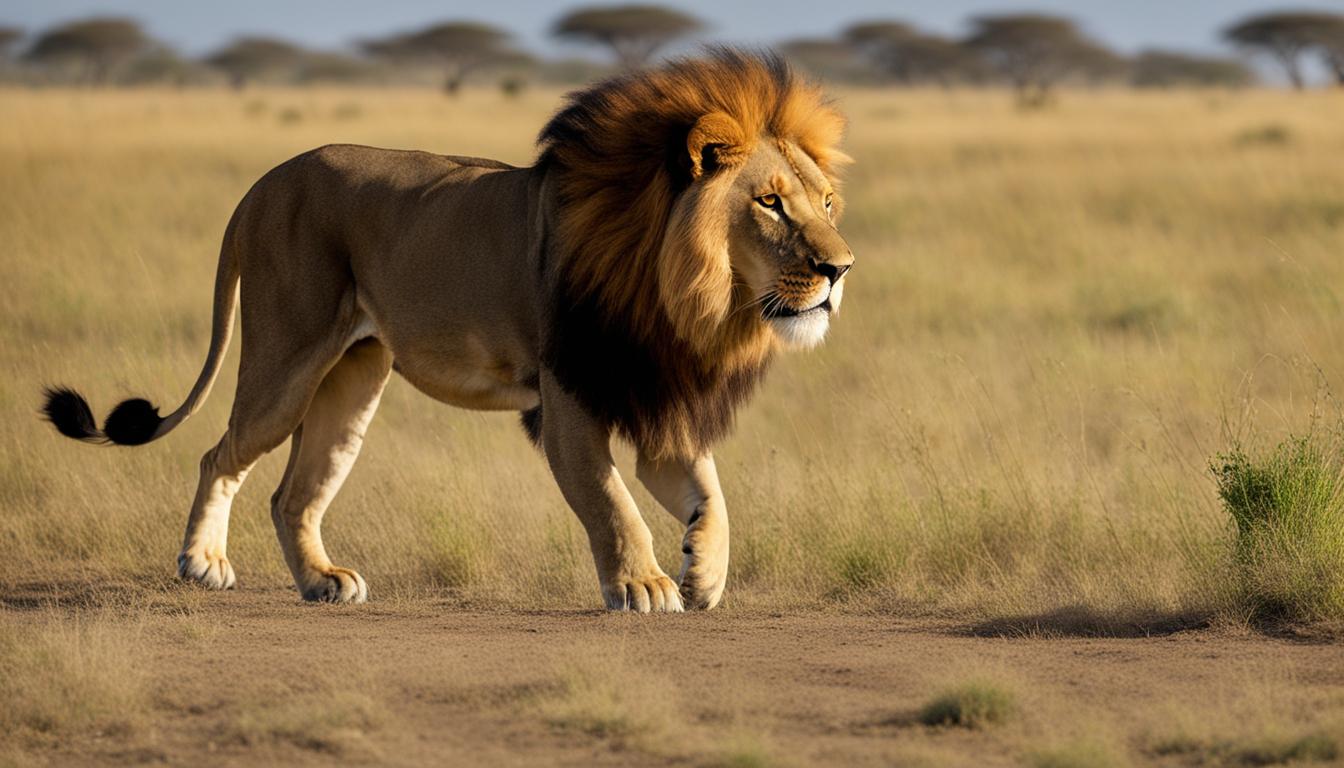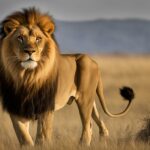Welcome to our article where we explore the fascinating diet and hunting habits of lions. Lions are known for their carnivorous diet, feasting on a variety of prey animals in order to survive. From their hunting techniques to their food choices, let’s dive into the world of these majestic creatures.
Key Takeaways:
- Lions are carnivores with a diet consisting primarily of meat.
- Prey animals for lions include antelopes, buffaloes, zebras, young elephants, and more.
- Male lions consume an average of 7kgs of food per day, while lionesses eat around 4.5kgs.
- Lions employ various hunting techniques such as stalking and ankle-tapping their prey.
- Lions are social animals and can hunt in groups, increasing their chances of catching prey.
Lion Hunting Techniques
Lions are skilled hunters with various techniques they use to catch their prey. They may not be the fastest runners, but they make up for it with their tactics and teamwork. Let’s explore some of the fascinating hunting techniques employed by lions:
Stalking Prey
When hunting, lions are masters of stealth. They stalk their prey by moving slowly and crouching near the ground, getting as close as possible without being detected. By blending into their surroundings, they can surprise their victims with a sudden pounce, giving their prey little time to react. Lions have excellent vision, allowing them to spot any movement from a distance.
Ankle-Tapping
When hunting smaller animals, lions often employ a technique known as ankle-tapping. They target the hind legs of their prey and swipe at them with their powerful paws. By tripping up their victims, lions make it easier to catch and overpower them. This technique requires precision and timing, as lions need to strike at just the right moment to bring their prey down.
Hunting in Groups
While lions are capable of hunting alone, they often prefer to hunt in groups, known as prides. Each lion has a specific role during the hunt, similar to positions in a football team. Some lions may act as scouts, keeping an eye on the prey and relaying information to the rest of the group. Others may surround the prey, cutting off any escape routes. Hunting in groups increases their chances of success, especially when targeting larger and more formidable prey.
“Lions may be the kings of the jungle, but it’s their teamwork and coordination that truly make them formidable hunters.” – Wildlife Expert
Ambush Tactics
While stalking is a common hunting technique, lions also employ ambush tactics when the opportunity presents itself. Instead of patiently stalking their prey, they may choose to run quickly towards their target, forcing it to run towards other waiting lions or into areas where it becomes trapped. Ambushes can be particularly effective when lions have identified vulnerable or unsuspecting prey.
| Hunting Technique | Description |
|---|---|
| Stalking Prey | Moving slowly and crouching near the ground to get as close as possible without being detected. |
| Ankle-Tapping | Tripping up smaller prey by targeting their hind legs with powerful swipes. |
| Hunting in Groups | Coordinating efforts and utilizing specific roles within a pride to increase hunting success. |
| Ambush Tactics | Quickly running towards prey to force it towards waiting lions or into trapping areas. |
These hunting techniques demonstrate the intelligence and adaptability of lions as skilled predators. By stalking, ankle-tapping, hunting in groups, and employing ambush tactics, lions have evolved to thrive in their natural habitats and secure their place as one of the most successful hunters in the animal kingdom.
Lion’s Feeding Behavior and Social Hierarchy
When it comes to feeding, lions have a unique behavior and social hierarchy within their pride. Male lions usually get the first pick of the meal, followed by the lionesses and finally the cubs. This reflects their dominance and the importance of their role as protectors and providers for the pride. It’s often said that male lions get the “lion’s share” of the kill, as they consume the largest portion of the prey.
Lions are not known for their sharing skills. In fact, they can be quite greedy and will fight over their food. The stronger individuals in the pride will often take the larger chunks for themselves, leaving the smaller, weaker lions to scavenge or go hungry. This competitive nature extends beyond their own pride, as lions will also defend their food from other predators, such as hyenas.
Lion scavenging and competition with hyenas can be quite intense. While lions are dominant over hyenas, these rival predators can put up a tough fight for their share of the kill. In some cases, hyenas may hold onto their food if they outnumber the lions, leading to an intense standoff. However, male lions’ strength and power often prevail, allowing them to overpower hyenas and claim their rightful portion of the meal.
| Lion’s Feeding Behavior and Social Hierarchy | Hyenas’ Competition for Food |
|---|---|
| Males eat first, followed by lionesses and cubs | Hyenas may fight for their share of the kill |
| Stronger lions get larger portions | Males are dominant over hyenas |
| Weaker lions may scavenge or go hungry | Lions can overpower hyenas in most cases |
Overall, the feeding behavior and social hierarchy of lions highlight their competitive nature and the struggle for survival in the wild. Male lions’ dominance, scuffles over food, and competition with other predators make feeding time an intense and fascinating spectacle in the animal kingdom.
Lion’s Diet and Nutritional Needs
Lions have a unique diet consisting solely of meat, making them obligate carnivores. Their nutrition requirements are met exclusively through animal tissue. Due to their large size and energy needs, lions require an average of 5kg to 7kg of meat per day. However, they can go without food for more than a week, as they have adapted to survive on irregular feeding patterns.
When lions do have a meal, they can consume up to 50kg of meat at once, which is nearly a quarter of their body weight. This high consumption is necessary to support their energy needs. Despite their ability to feast on large quantities of food, lions do not need to eat every day and can go without food for three to four days.
Lions are well adapted to their meat-only diet and possess the physiological characteristics necessary for efficient digestion and absorption of nutrients from animal tissue. Their digestive system is designed to process and utilize the high protein content found in meat. This enables them to thrive on a diet devoid of plant matter.
| Nutritional Needs | Amount |
|---|---|
| Protein | High |
| Fat | Moderate |
| Carbohydrates | Minimal |
| Vitamins and Minerals | Derived from prey |
Lion’s Feeding Frequency
Feeding frequency varies among lions and is influenced by factors such as availability of prey and competition from other predators. Lions have the ability to gorge on a large kill and then endure periods without food. This adaptation allows them to survive in environments where prey availability may be unpredictable.
- Lions may feed every three to four days.
- They can go without food for more than a week.
- Feeding frequency is influenced by the size and success of hunts.
In summary, lions have a specialized diet that consists solely of meat. They are well adapted to their nutrition requirements, deriving their energy and essential nutrients from animal tissue. Their ability to consume large quantities of food and endure periods without eating contributes to their survival in the wild.
Lions and Water Sources
Lions are known for their strategic choice of habitat, often opting to live near rivers, streams, and waterholes. This behavior is not driven solely by thirst; instead, lions are aware that their prey animals will inevitably come to these water sources to drink. Patiently waiting near these watering holes, lions increase their chances of a successful hunt. Moreover, areas with abundant water often experience flooding, which forces lions to demonstrate their swimming prowess in order to catch their food. Swimming not only provides exercise for lions but also contributes to their muscular physique, making them powerful hunters akin to Olympic swimmers.
In their natural habitats, lions are highly adaptable creatures that have evolved to survive and thrive. Their proximity to water sources is a testament to their resourcefulness and ability to exploit opportunities for sustenance. By positioning themselves near rivers and waterholes, lions maximize their chances of securing a meal and sustaining their dietary needs.
The Benefits of Hunting near Waterholes
Hunting near waterholes offers several advantages for lions. Firstly, it increases their chances of encountering prey, as many animals are drawn to these water sources due to their essential need for hydration. Lions capitalize on this predictable behavior and patiently wait for their unsuspecting victims to come within striking distance. Secondly, the presence of water creates an environment where prey animals may become more vulnerable. Oftentimes, while drinking at the waterhole, animals may let their guard down, making them easier targets for the ambush tactics employed by lions. Lastly, waterholes provide lions with a strategic advantage as they can trap their prey near the water’s edge, eliminating their potential escape routes and ensuring a successful hunt.
To illustrate the significance of water sources to lions, we’ve compiled a table detailing various aspects of their hunting behavior near these vital habitats:
| Hunting Behavior | Effectiveness |
|---|---|
| Ambush Tactics | High success rate due to animals’ vulnerability while drinking |
| Increased Prey Encounter Rate | Significantly higher likelihood of encountering prey animals |
| Strategic Trapping | Lions can corner their prey near the water’s edge, reducing potential escape routes |
By understanding lions’ preference for water sources and their hunting strategies in these areas, we gain insight into the remarkable adaptability and intelligence of these majestic creatures.
Conclusion
Lions are fascinating creatures with a unique diet and hunting behavior. Their carnivorous nature is evident in their food choices, which range from antelopes and zebras to elephants and giraffes. Lions are skilled hunters, employing various techniques such as stalking and ankle-tapping to catch their prey. They can hunt alone but often prefer to work together in groups to increase their chances of success.
Despite their social hierarchy within the pride, lions are not good at sharing their food. Male lions usually eat first, followed by lionesses and cubs. They are also known to scavenge and steal food from other animals or eat leftovers after a kill. Living near water sources is advantageous for lions as it allows them to patiently wait for prey animals to come and drink, increasing their hunting opportunities.
Overall, the lion’s diet and hunting behavior exemplify their remarkable adaptation to survive and thrive in their natural habitats. Their carnivorous nature, combined with their hunting techniques and social dynamics, make lions one of the most fascinating and majestic animals in the animal kingdom.
What Similarities are There Between Tiger and Lion Hunting Tactics?
Tigers’ hunting tactics share many similarities with those of lions. Both big cats are skilled stalkers, using stealth and camouflage to approach their prey unnoticed. They rely on their incredible speed and agility to launch powerful ambush attacks. Both species excel at hunting large herbivores, but will opportunistically target smaller prey when necessary. Flanking and pouncing on their targets, tigers and lions utilize their strong jaws to deliver a suffocating bite to the throat. These similarities in hunting tactics demonstrate the impressive predatory instincts of these majestic felines.
FAQ
What do lions typically eat?
Lions have a carnivorous diet consisting mainly of meat. They eat a variety of animals, including antelopes, buffaloes, zebras, young elephants, rhinos, hippos, warthogs, crocodiles, and giraffes.
How do lions hunt their prey?
Lions employ various hunting techniques such as stalking and ankle-tapping their prey. They can also hunt in groups, increasing their chances of catching prey. Lions can ambush their prey and run quickly to force it into areas where it becomes trapped.
What is the feeding behavior and social hierarchy of lions?
Male lions usually eat first after a kill, followed by lionesses and then cubs. Lions have a social hierarchy within the pride, and the stronger individuals often get to eat first. Lions are not good at sharing and will fight over their food. They are also scavengers and will steal food from other animals or eat leftovers.
What is the lion’s diet and nutritional needs?
Lions have a meat-only diet, deriving their energy and nutrient requirements exclusively from animal tissue. They need an average of 5kg to 7kg of meat per day and can consume up to 50kg of meat in one meal. Lions can go without food for more than a week and do not need to eat every day.
Why do lions live near water sources?
Lions often choose to live near rivers, streams, and waterholes as it allows them to wait for prey animals to come and drink. They patiently wait near these water sources for their dinnertime. Areas with abundant water often flood, forcing lions to swim to catch their food.
How do lions adapt to survive and thrive in their habitats?
Lions have unique hunting patterns and a carnivorous diet, showcasing their remarkable adaptation to survive. They eat a wide range of prey animals and employ various hunting techniques. Living near water sources and hunting in groups are some of the strategies lions use to thrive in their natural habitats.









